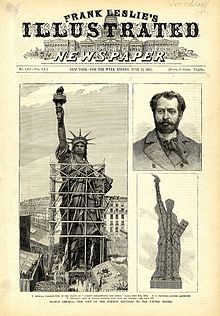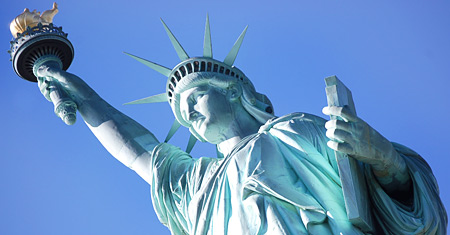“The Statue of Liberty Enlightening the World” is recognized as a universal symbol of freedom and democracy. The Statue of Liberty was dedicated on October 28, 1886. It was designated as a National Monument in 1924. Employees of the National Park Service have been caring for the colossal copper statue since 1933.


Drawing of The Statue of Liberty
The foundation of Bartholdi's statue was to be laid inside Fort Wood, a disused army base on Bedloe's Island constructed between 1807 and 1811. Since 1823, it had rarely been used, though during the Civil War, it had served as a recruiting station. The fortifications of the structure were in the shape of an eleven-point star. The statue's foundation and pedestal were aligned so that it would face southeast, greeting ships entering the harbor from the Atlantic Ocean.In 1881, the New York committee commissioned Richard Morris Hunt to design the pedestal. Within months, Hunt submitted a detailed plan, indicating that he expected construction to take about nine months. He proposed a pedestal 114 feet (35 m) in height; faced with money problems, the committee reduced that to 89 feet (27 m).
Hunt's pedestal design contains elements of classical architecture, including Doric portals, as well as some elements influenced by Aztec architecture. The large mass is fragmented with architectural detail, in order to focus attention on the statue. In form, it is a truncated pyramid, 62 feet (19 m) square at the base and 39.4 feet (12.0 m) at the top. The four sides are identical in appearance. Above the door on each side, there are ten disks upon which Bartholdi proposed to place the coats of arms of the states (between 1876 and 1889, there were 38 U.S. states), although this was not done. Above that, a balcony was placed on each side, framed by pillars. Bartholdi placed an observation platform near the top of the pedestal, above which the statue itself rises. According to author Louis Auchincloss, the pedestal “craggily evokes the power of an ancient Europe over which rises the dominating figure of the Statue of Liberty”.The committee hired former army General Charles Pomeroy Stone to oversee the construction work. Construction on the 15-foot-deep (4.6 m) foundation began in 1883, and the pedestal's cornerstone was laid in 1884.In Hunt's original conception, the pedestal was to have been made of solid granite. Financial concerns again forced him to revise his plans; the final design called for poured concrete walls, up to 20 feet (6.1 m) thick, faced with granite blocks.This Stony Creek granite came from the Beattie Quarry in Branford, Connecticut. The concrete mass was the largest poured to that time.
Norwegian immigrant civil engineer Joachim Goschen Giæver designed the structural framework for the Statue of Liberty. His work involved design computations, detailed fabrication and construction drawings, and oversight of construction. In completing his engineering for the statue’s frame, Giæver worked from drawings and sketches produced by Gustave Eiffel.
USA RECORDS ORGANIZATION_USKINGS








